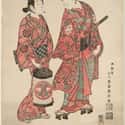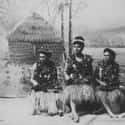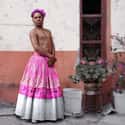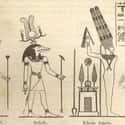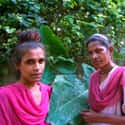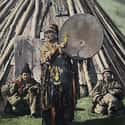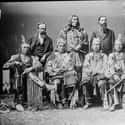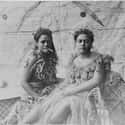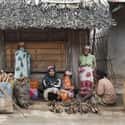-
(#1) Wakashu - Japan
Also known as "beautiful youths," the wakashu of Japan emerged as a widely accepted third gender during the Edo period. The wakashu were generally adolescent boys who were androgynous in appearance and behavior. Woodblock prints of the time depicted them as playful, sensual, and feminine.
Japanese culture portrayed them to be objects of desire for both women and men, at least until Western culture became more prominent and the tradition slowly faded away.
-
(#2) Māhū - Hawaii
In native Hawaiian culture, Māhū means someone who embodies both male and female spirits. Instead of identifying more as a male or more as a female, they accept both equally and see gender as a beautiful, flowing thing. More than just accepted in Hawaiian society, Māhūs are revered, their fluidity considered an empowering force.
Instead of viewing their "differentness" as a problem, they see their dual-spirits as a way to navigate life's challenges with grace, a true liberation.
-
(#3) Muxe - Mexico
Muxes are a third gender originating in Oaxaca, Mexico. The word muxe said to come from the Spanish word for woman, "mujer." While muxes are usually men who identify more as women, muxes may also be those who simply don't fall into the traditional male-female or gay-straight categories (the indigenous people of the area don't actually see gender in that way). They tend to be quite skilled in arts like sewing and embroidery, and will often be the caretakers for their parents as they grow older.
Since the '70s, Oaxaca annually holds a festival in their honor called Vela de las Intrepidas, or Vigil of the Intrepids.
-
(#4) Bissu - Indonesia
Bissu is actually the fifth gender acknowledged by Indonesians, known as a meta-gender. Bissu translates as "transvestite priest," a somewhat inaccurate translation because the term "transvestite" refers to wearing clothes of the opposite gender. Rather than cross-dressing, the bissu actually wear their own unique type of garb. They are seen as being both male and female at once, but with a twist. Indonesian culture believes a bissu who presents as outwardly male exists internally as a female, and vice versa.
Since Indonesians view bissu as conductors of spirits, the bissu often lead ceremonies or provide blessings.
-
(#5) Khawaja Sira - Pakistan
Individuals in Pakistan who identify as Khawaja Sira occupy a complex place in society - they simultaneously receive praise as being "gifted by god" but also face intense discrimination. Khawaja Sira individuals are usually rejected by their families, but form their own family trees through their system of gurus and apprentices.
Although Pakistan has been slow to embrace the modern transgender movement, their traditional Khawaja Sira gender identity remains an ancient custom; their religious devotion led the Hindu deity Ram to declare the Khawaja Sira the final rulers of the human race.
-
(#6) Xanith - Oman
Oman remained isolated from the world until the 1970s, and because of this solitude the country formed a slightly different view of sexuality than its neighbors. They recognize a third gender known as Xanith, which refers to a man who behaves like a woman and plays the passive role in homosexual relationships.
Because of this behavior, Xaniths are subject to the same laws of society that apply to women. They are not allowed to cross dress, but they dress in a similar fashion as women and frequently operate as sex workers.
-
(#7) Sḫt (Sekhet) - Egypt
One of the oldest known examples of a third gender come from Egypt . Pottery shards from between 2000 and 1800 BCE depict three distinct genders - male, female, and sekhet , which was neither male nor female.
The drawings of the male and female characters both include anatomically correct privates, but the sekhet drawing appears to be a man with no member.
-
(#8) Hijra - India
The hijras of southeast Asia belong a long and colorful history, with deep cultural ties in India. The group, which encompasses many forms of homosexual and transgender individuals, experienced ups and downs in status over the years. In the Hindu religion, the deity Shiva's bonding with his wife Parvati to form the being Ardhanari shows an ancient depiction of a hijra idol.
While once held in high esteem, the hijra lost much of their status when British colonizers criminalized the hijra way of life. However, in modern times, they have become somewhat celebrated once again, and just recently received official recognition as a third gender in India.
-
(#9) Ergi - Siberia
The meaning of the word "ergi" changed many times over the decades, but it originally referred to Siberian shamans who embraced a different type of sexuality. The medicine men of the Chukchi, Koryak, and Kamchadal tribes were seen as spirit workers, with the spirits offering them guidance as they flowed between their gender roles.
They typically assumed female roles at home, some later in life, and often wore women's clothing.
-
(#10) Two-Spirit - North America
Among the indigenous tribes of North America, there exists a unique view of sexuality. The term "two-spirits" covers a wide group of people, and remains loosely accepted as a blanket term across a collection of over 150 tribes. If a young boy showed interest in traditionally female roles, tribes performed different rituals and celebrations to determine if the child possessed the two-spirits.
In almost all of the cultures, two-spirits received much reverence until the colonialization of America by European settlers. Elders said that they were "gifted among all beings because they carried two spirits, that of male and female."
-
(#11) Kathoey - Thailand
Thailand holds a status as a country famous for its acceptance of different sexual identities. But the roots of the kathoey, or "lady boy," tradition go a lot deeper than most people may realize. Thailand is a primarily Buddhist nation, and Buddhism actually recognizes four distinct genders, and from one of those four comes the "kathoey." Kathoey are typically transgender women, though not all trans women see themselves as kathoey. It's deeply tied to spirituality and religion, which is why some trans women choose not to identify as kathoey.
They are generally accepted in most major cities, and at least tolerated in smaller villages. In some instances, citizens consider kathoey to be a form of karma, resulting in their respect as everyone will go through one of their lives as kathoey. The kathoey are also viewed as conduits for both male and female spirits, lending them sometimes statuses of high regard in Thai society.
-
(#12) Fa'afafine - Samoa
In Samoan society, the literal translation of Fa'afafine is "in the manner of (fa'a) a woman (fafine)." A gender identity widely accepted today, Fa'afafine potentially goes back for many generations. They don't follow the Western standards of binary sexual orientation, so little boys who display very feminine qualities are considered totally normal.
In Samoan society, tolerance of all individuals remains a high priority.
-
(#13) Sekrata - Madagascar
In Madagascar, when young boys show effeminate traits, their families simply raise them as females. Most eventually forget they were actually born males. The people of Madagascar see this practice as a totally normal and natural part of life, particularly the Antandroy and Hova groups.
Sekrata view themselves as "real" women, wearing long hair, decorative jewelry, and silver coins in their pierced ears. It is also believed supernatural beings who protect them from any harm.
New Random Displays Display All By Ranking
About This Tool
The history of the third gender has been very long and this topic has always been extremely controversial. Since ancient times, humans have always divided gender into two different. In fact, there are more genders than we recognize or express. As early as January 2013, the Nepalese government agreed to issue a third-gender identity card, which makes life more convenient for sexual minorities in Nepal. Germany has also become the first country in Europe to recognize the third gender.
More and more countries have introduced relevant policies and laws to protect the equal rights of people with different gender perceptions, which is the next level interpretation of freedom and human rights. Here you can know more about the third gender from cultures in different countries.
Our data comes from Ranker, If you want to participate in the ranking of items displayed on this page, please click here.











